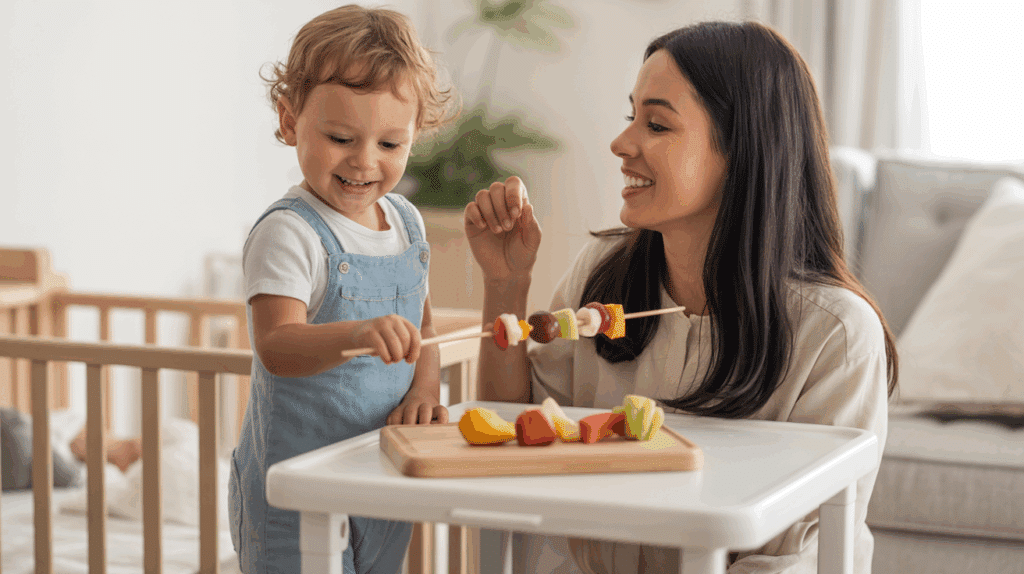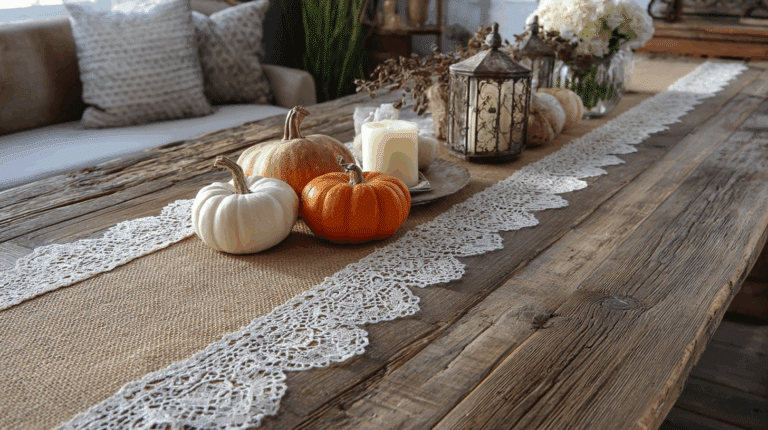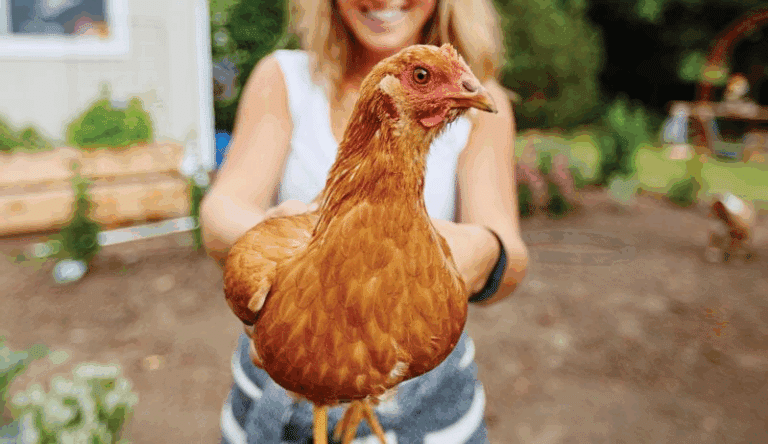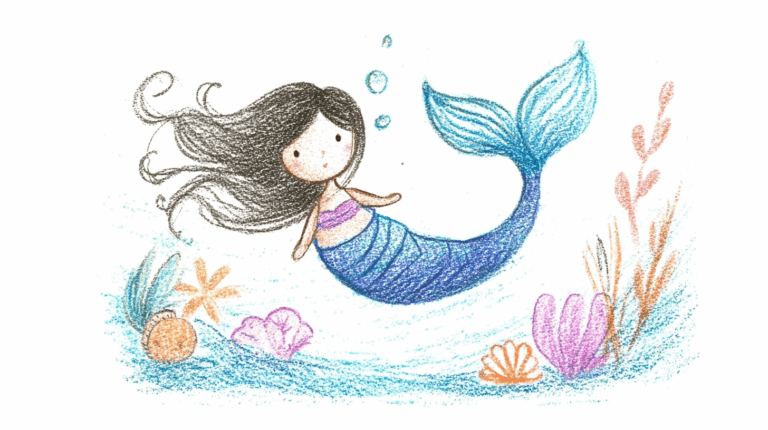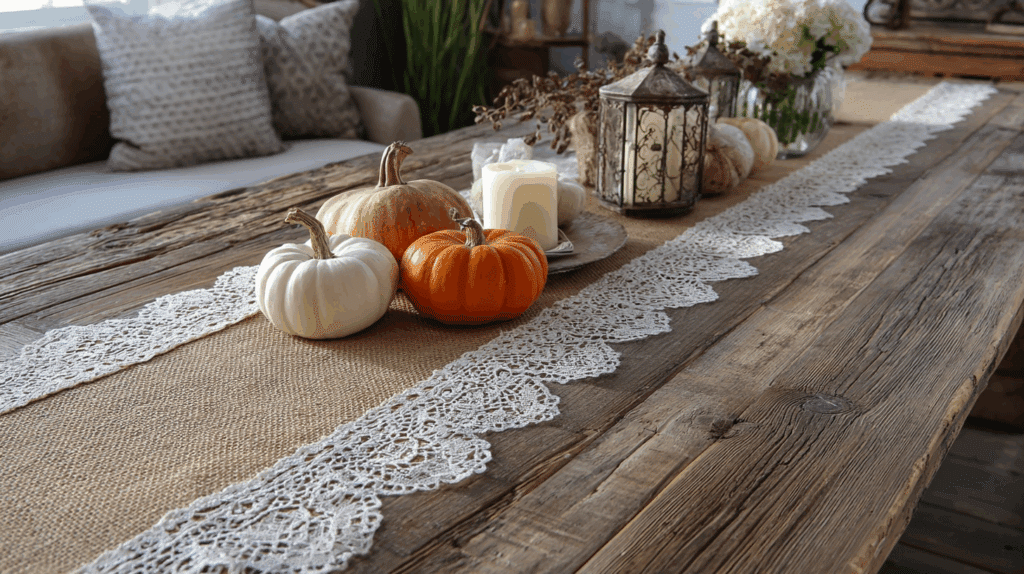Parents often struggle to keep small hands busy in the kitchen. But what if those little hands could learn while having fun with food?
Food activities for preschoolers turn ordinary kitchen time into learning moments. Through simple food tasks, kids develop motor skills, understand basic math, and build confidence.
This blog will show you simple food activities for preschoolers that anyone can try at home. No fancy tools or chef skills are needed- just regular kitchen items and a bit of patience.
Let’s get those tiny chefs started!
The Power of Food Play: Why it Matters for Preschoolers?
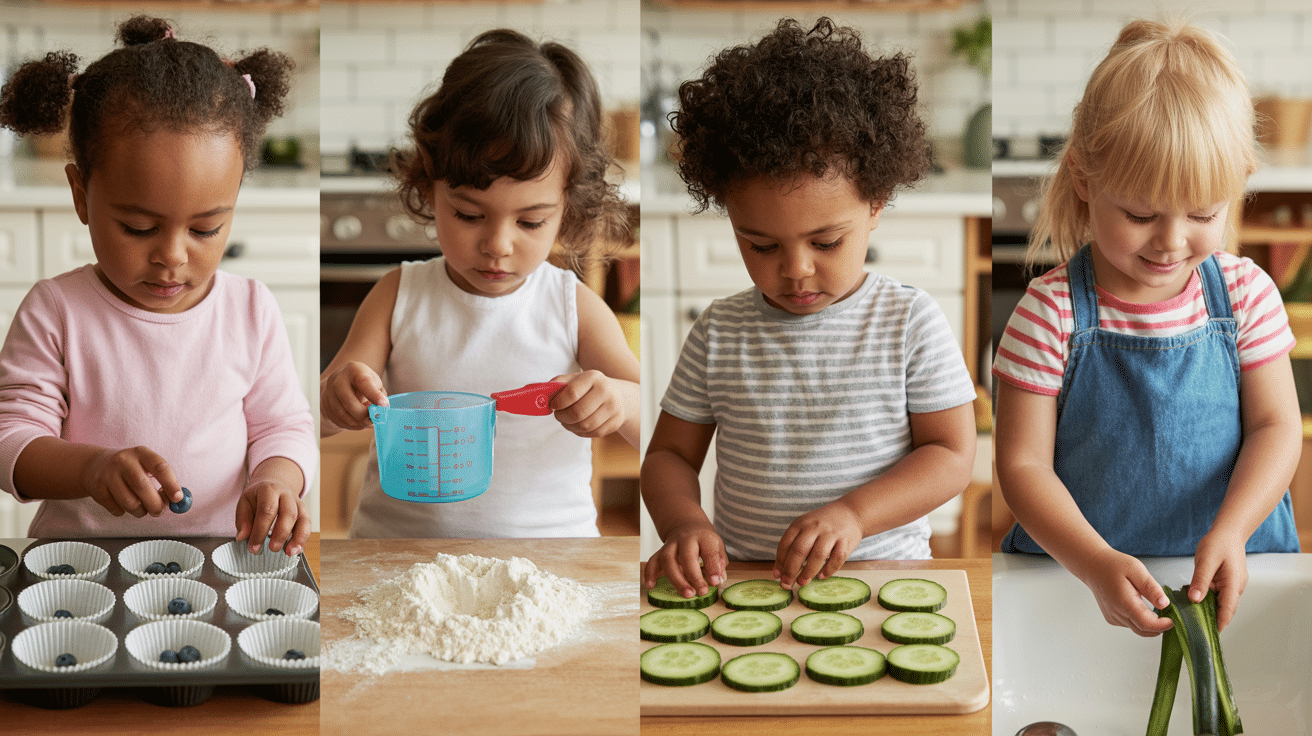
Food play does more than keep kids busy – it helps them grow in many ways.
When children touch and mix foods, they learn about the world through their senses. Kids who play with food often eat better later and pick up basic math when counting pieces or sharing food.
Small hands get stronger by peeling fruit or pouring milk, which helps with writing skills down the road.
These kitchen moments build strong bonds between kids and adults. Children also learn:
- Patience while waiting for food to cook
- Safety rules like hand washing
- Social skills by taking turns
- New words to talk about what they’re doing
Cooking and Fun: Food Activities for Preschoolers
Getting kids in the kitchen opens a world of fun and learning. Small hands can do big things with simple food tasks that feel like play.
These easy cooking moments teach skills while making memories. Let’s look at some food activities for preschoolers that mix learning with tasty results.
Sensory Activities: Exploring Textures, Colors, and Smells
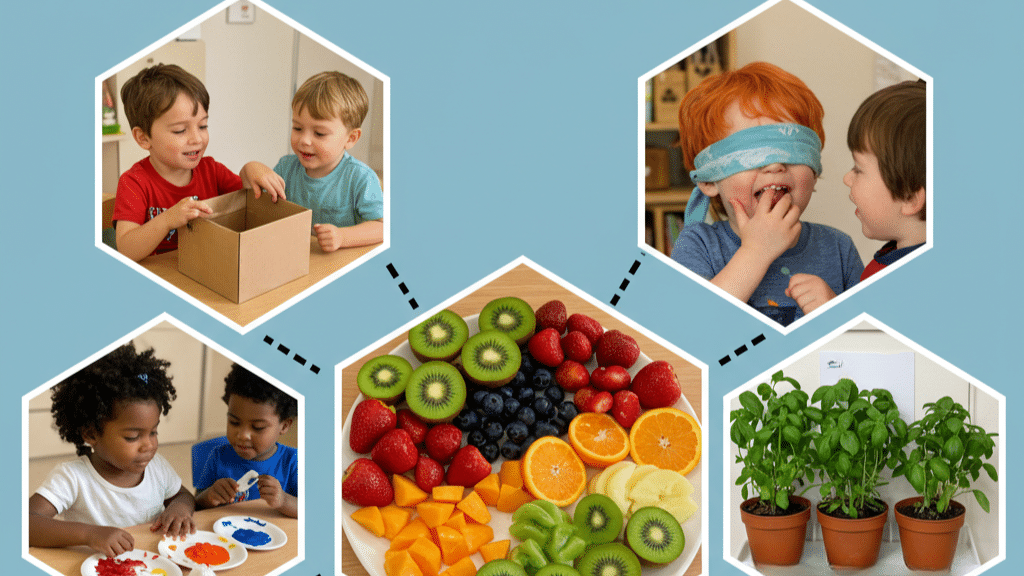
1. Fruity Feel Box
Create a box with holes for hands. Place fruits with different textures inside. Let kids feel and guess what’s in the box. This helps them connect touch with food items before tasting.
- Use fruits with distinct textures: bumpy oranges, fuzzy kiwis, smooth apples
- Ask questions like “Is it bumpy or smooth?” to build vocabulary
- Switch items regularly to keep interest high
2. Spice Painting
Mix food coloring with vanilla, cinnamon, or cocoa. Let kids paint on paper plates with small brushes. They’ll enjoy the smells while creating art that’s safe if fingers go in their mouths. The different spices create unique scents that stimulate their sense of smell while they develop.
3. Rainbow Fruit Tray
Arrange fruits by color in a circle. Blindfold kids and have them smell and taste each fruit. Ask them to guess the color and name of each fruit based on smell and taste alone. This builds the connection between the senses and helps them learn to identify foods without seeing them.
- Red: Strawberries, Watermelon
- Orange: Oranges, Cantaloupe
- Yellow: Banana, Pineapple
- Green: Kiwi, Green Apple
- Blue/Purple: Blueberries, Grapes
4. Herb Garden Touch Test
Grow small pots of basil, mint, and rosemary. Let kids touch the leaves, smell their hands, and talk about the smells. They can help water the plants and watch them grow. This creates a farm-to-table understanding and builds plant care skills.
5. Cool vs. Warm Foods
Prepare foods at different temperatures – cold yogurt, room temperature banana, warm bread. Let kids touch (safely) and describe how each feels. This builds food words and temperature awareness.
Through direct experience, they’ll learn concepts like “melting,” “cooling,” and “warming.” Try adding a simple chart with faces showing “cold,” “warm,” and “hot” for kids to match with each food item.
6. Rice and Bean Bins
Fill small bins with dry rice and beans of different sizes. Add measuring cups and spoons for scooping and pouring. This activity builds fine motor skills and introduces concepts of volume and texture.
The different sounds when they pour also add to the sensory experience.
- Add small toys like plastic animals for a hide-and-seek game
- Include funnels of different sizes for pouring challenges
- Try colored rice (dyed with food coloring) for visual appeal
7. Scented Play-Dough
Make homemade play dough with different food extracts like lemon, mint, or almond. Kids can help mix ingredients, knead the dough, and create shapes. The smells add an extra sensory dimension to a classic play activity.
Food Sorting and Matching Games for Early Learning
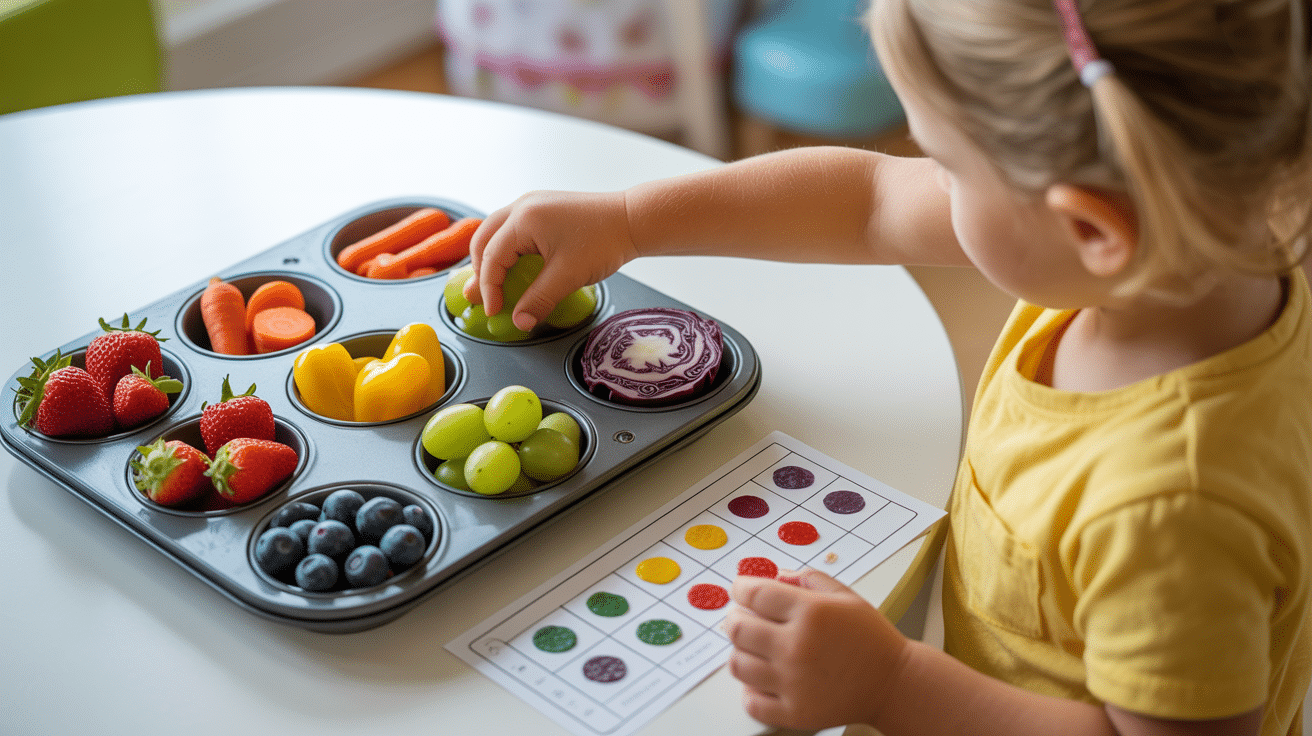
8. Color Sorting Snacks
Give kids a muffin tin and colorful foods like Fruit Loops, M&M’s, or fruit pieces. Ask them to sort by color into different sections. This teaches color recognition and sorting skills while working with food.
- Start with 2-3 colors for younger kids
- Add more colors as they master the basics
- Count items in each section for added math practice
9. Shape Sandwich Cutters
Use cookie cutters to create sandwiches in different shapes. Have kids match the sandwich shapes to drawn shapes on paper plates. Talk about circles, squares, triangles, and stars while they enjoy their lunch.
10. Food Group Sorting
Print pictures of different foods or use toy food items. Help kids sort them into food groups (fruits, veggies, grains, protein). This teaches nutrition basics and categorization skills in a hands-on way. Create simple labels with both words and pictures to mark each group’s container.
You can turn this into a movement game by placing containers around the room and having kids run to put each food in its right spot.
11. Texture Matching Pairs
Create cards with food textures (smooth, bumpy, rough) and actual food examples. Have kids match the texture word to the food. This builds vocabulary and sensory awareness together.
For younger kids, start with just two textures like “smooth” and “bumpy” before adding more complex ones like “grainy” or “fuzzy.” You can extend this game by creating a texture scavenger hunt around the kitchen, asking kids to find items that match each texture card.
12. Size Sequencing Snack
Provide foods that come in different sizes, like crackers, apple slices, or cucumber rounds.
Have kids arrange them from smallest to largest before eating. This teaches size comparison and sequencing. Try using a ruler or measuring tape to show how size can be measured with numbers.
Snack Construction: Building Edible Creations
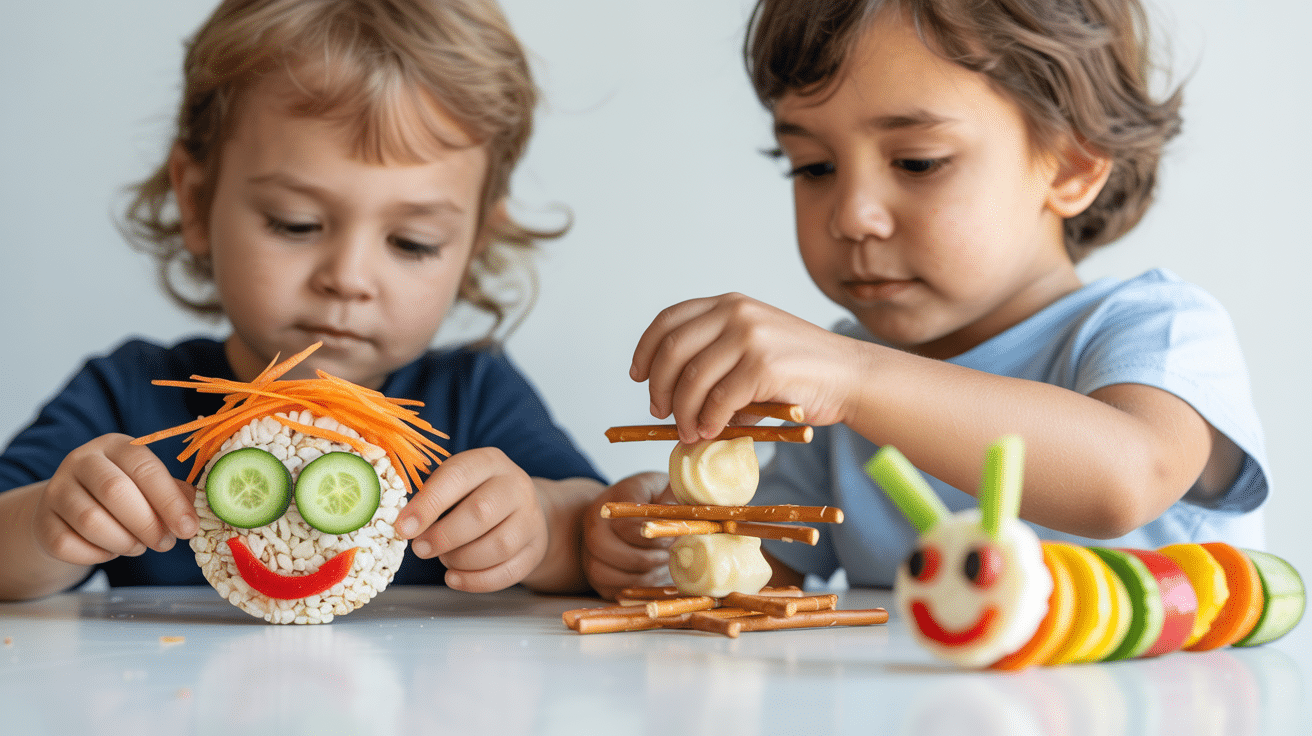
13. Fruit and Veggie Faces
Provide a plate with a variety of cut fruits and vegetables. Let kids create funny faces on a round cracker or bread base. This activity encourages creativity and helps kids see produce in a fun way.
- Cucumber slices make great eyes
- Bell pepper strips work well for mouths
- Shredded carrots make silly hair
- Blueberries can be used for pupils or buttons
14. Sandwich Stackers
Set out bread, cheese slices, lunch meat, and veggie toppings. Let kids build their own sandwich towers, talking about layers and balance as they work. They’ll learn about structure while creating their lunch. For added fun, try using cookie cutters to make shapes from each layer.
Talk about the food groups as they add each item, turning lunch into a nutrition lesson. You can also add a chart where kids draw or place stickers for each item they used.
15. Pretzel Log Cabins
Show kids how to build simple structures using pretzel sticks and soft cheese as “glue.”
This edible engineering project builds fine motor skills and spatial thinking. Kids love creating something they can eat afterward! Start with a simple square house, then try more complex shapes as skills grow.
Take photos of their creations before eating to create a “construction portfolio.” This activity works well for parties where each child can build their own small cabin.
16. Banana Split Building
Set up a banana split station with banana halves, small scoops of ice cream, and toppings. Let kids design their dessert, talking about patterns and symmetry as they add toppings to each side. This makes a great reward activity after completing other tasks.
17. Trail Mix Creation Station
Let kids create personal trail mix blends by selecting and measuring ingredients from different containers. This teaches measurement concepts while allowing for personal choice.
- Offer measuring spoons in different sizes.
- Talk about “more” and “less” as they scoop.
- Discuss healthy combinations and balanced choices.
18. Edible Necklaces
String items like O-shaped cereal, small pretzels, or fruit loops onto clean yarn. Kids practice fine motor skills while creating wearable, edible art.
This is perfect for kids who need extra practice with finger dexterity. Try using patterns (two green, one yellow, two green) to add a math element to the activity.
For older preschoolers, set out bowls with different items and let them create patterns on their own. This activity can be adapted for holidays with themed colors like red and green for Christmas.
19. Food Puzzle Plates
Cut sandwiches or quesadillas into simple puzzle pieces before serving. Kids must reconstruct their food before eating, adding a problem-solving element to mealtime and making eating more engaging.
20. Mini Pizza Artists
Provide English muffin halves, sauce, cheese, and toppings. Let kids design their own mini pizzas. Talk about circles, spreading evenly, and arranging toppings while they create their masterpieces.
- Set out toppings in small bowls for easy access.
- Suggest faces, animals, or letter shapes that they can create.
- Take photos of their creations before baking.
- Talk about how cheese melts and changes during cooking.
- Consider a “pizza gallery” where kids present their creations.
21. Parfait Layering
Help kids create yogurt parfaits with alternating layers of yogurt, fruit, and granola. This teaches pattern recognition and layering concepts. The clear cups help them see each layer clearly.
On hot days, try freezing the finished parfaits for a popsicle-like treat.
You can create a simple chart showing the order of layers for kids to follow like a recipe. This activity works well for teaching words like “top,” “bottom,” “middle,” and “between” as you guide them through the process.
Food-Themed Sensory Bins
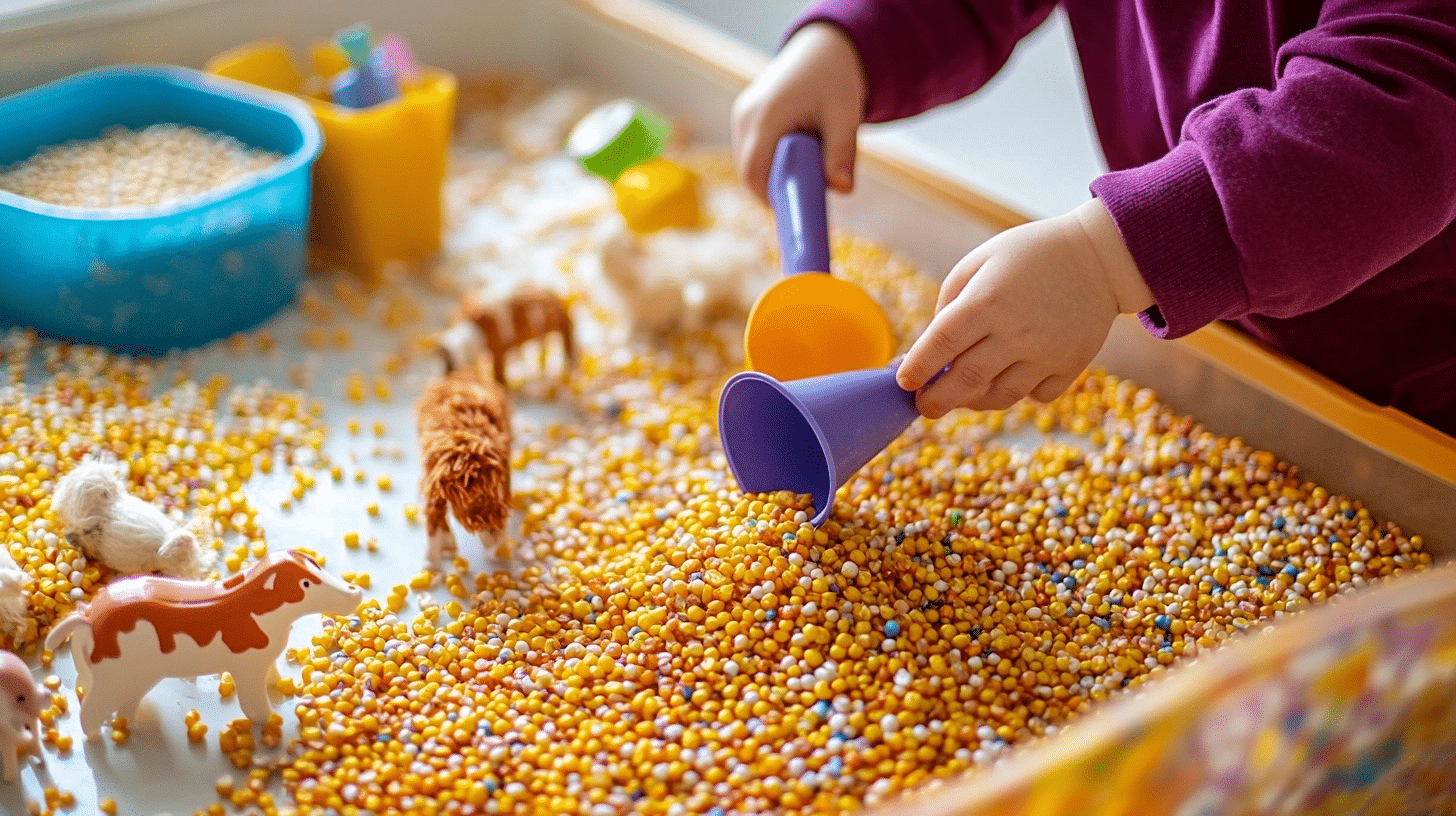
Sensory bins offer hands-on learning that kids love. Food activities for preschoolers centered around touch and feel help build brain connections through play.
These bins use food items as tools for learning rather than eating.
A tray of dry pasta becomes a spot for scooping and pouring. Rice turns into a base for finding hidden toys. Dried beans become counting tools. What makes food activities for preschoolers special is how they engage all senses.
Kids see colors, feel textures, hear sounds as items move, and sometimes smell scents too.
Parents can change bin contents based on seasons or themes. For example, in the fall, corn kernels and mini pumpkins might be included, while in the winter, cinnamon sticks in a rice base might be featured.
Wrapping It Up
Food play opens many doors for young learners. Through the food activities for preschoolers we’ve shared, children gain skills they’ll use for years to come.
What can you try first? Perhaps start with a simple rice bin or fruit sorting game. Notice how your child responds, then build from there.
We’d love to hear which activity your little one enjoyed most!
Share your experience in the comments below or try our simple food play printable to get started today.


